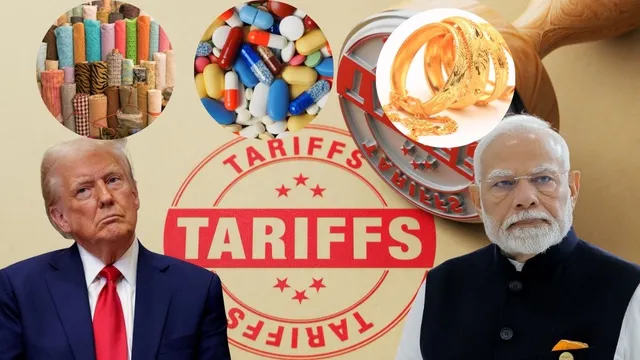- By Aditi Priya Singh
- Thu, 07 Aug 2025 11:54 AM (IST)
- Source:JND
Indian Business Sectors Affected by Trump's Tariff: In a surprising move, the United States recently, under Donald Trump, decided to implement a 50% tariff on several Indian goods, creating a new target in its trade tensions around the world. This tariff hike is part of a larger strategy in a trade and tariff war that the United States has begun against countries across the globe. For India, this is a large blow since America is one of its largest trading partners. Many businesses in India rely on American exports; now, their goods are more than 50% more expensive for the American consumer. There will be diminished demand due to a lack of competitiveness, decreased profits, and perhaps layoffs across industries.
Business Sectors in India That Will Be Most Affected By Trump's 50% Tariff
Sectors like textiles, automobiles, IT, pharmaceuticals, marine exports and gems & jewellery are expected to suffer the most. These sectors not only earn India a lot of foreign money but also provide jobs to crores of people. If this trade war continues, it could deeply affect India’s economy, especially small businesses and exporters who rely heavily on the U.S. market. India may need to look for alternative markets or renegotiate trade terms.
| Business Sector | Estimated People Employed |
|---|---|
| Textile Industry | 4.5 crore |
| Auto Sector | 3 crore |
| IT and Electronic Sector | 1.5 crore |
| Marine Products | 50 lakh |
| Gems and Jewellery | 50 lakh |
| Pharmaceutical Industry | 27 lakh |
Source: PIB and other government sources
1. Textile Industry
India's textile sector is one of the largest job providers in the country, estimated to support over 4.5 crore workforces (as reported by the Press Information Bureau). If the U.S. imposes a 50% tariff on Indian textile exports, it will huge impact on demand for Indian garments in the American market. This will hurt small and medium manufacturers, employment in rural areas, and lead to a fall in foreign exchange earnings. India may lose to its competitive suppliers, such as Bangladesh and Vietnam, mwhich ight offer more competitive pricing.
2. Automobile Sector
With over 3 crore people in the Indian auto industry (as per the Automotive Skill Development Council), a massive 50% tariff on exports of vehicles and auto parts to the US could be an area of great concern. Indian vehicle manufacturers and suppliers of auto parts, predominantly located in Pune, Chennai and Gurgaon, would see a downturn in orders. It can result in lost jobs, reduction in production and revenue loss for many small vendors who depend heavily on contracts from the greater U.S. market.
3. IT and Electronic Sector
India’s IT and electronics business, which has around 15 million (1.5 Crore) people employed, could suffer significantly from Donald Trump's raised tariffs. A 50% increase in import duty would discourage American companies from buying hardware or outsourced technology services from India. This will negatively impact export levels and may slow the emerging growth of technology startups and contract manufacturers. It may limit any potential future investment in India’s Make-in-India electronic hubs.
4. Marine Products
India’s marine industry, which gives livelihood to nearly 50 lakh people, especially in coastal states like Kerala, Andhra Pradesh and Gujarat, could be deeply impacted by such tariffs. The U.S. is a major importer of Indian shrimp and other seafood. This much tariff will make Indian seafood expensive and less attractive to U.S. buyers, leading to a possible fall in exports, price crashes in domestic markets, and distress among the fishing communities.
5. Gems and Jewellery
Another potential area of impact is the gems and jewellery industry that employs approximately 50 lakh people, particularly in cities like Surat and Mumbai. A steep tariff imposed on diamond, gold jewellery and alternative items exported to the U.S. will only serve to increase the final price of Indian products, and it is unlikely that American consumers would pay a premium for Indian-made items. Thus, it is likely that many artisans and small-scale producers, especially, may be forced to suspend production or even shut down, affecting livelihoods and export revenue.
6. Pharmaceutical Industry
The pharmaceutical industry in India employs more than 27 lakh people and is recognised across the globe for its production of low-cost generic medicines. Suppose the U.S. imposes a 50% tariff on imported medicines from India. In that case, Indian medicines may cost significantly more due to supply and demand, as the U.S. is one of the largest markets for Indian pharmaceutical exports. If the major pharma companies and contract manufacturing units in India were to face a decline in demand for exported medicines as a result of the tariff, then it seems likely there could be slower innovation and production growth in the Indian Pharma sector.
India's top Items exported to the United States
| Export Item | Export Value (in Billion USD) |
|---|---|
| Smartphones | 10.6 |
| Diamonds | 4.9 |
| Uncategorized Medicines | 4.0 |
| Petroleum Products | 3.2 |
| Diamond Jewellery | 2.4 |
| Anticancer Drugs | 1.8 |
| Shrimp | 1.8 |
| Petrol, Solar Panel, Vehicle Accessories | Not Specified |
Source: Ministry of commerce and industry
ALSO READ: What Is Tariff Plan And Why Donald Trump Is Imposing 25% Tariffs On India? Know All About It
Why Trump Is Putting Heavy Tariffs Of 50% On India?
Donald Trump is putting heavy tariffs on India because he wants India to reduce its imports from countries like Russia, Iran, and China. He believes India should rely more on U.S. goods instead. This move also came after Prime Minister Modi clearly stated that no foreign leader played a role in the India-Pakistan ceasefire, which may have upset Trump.

